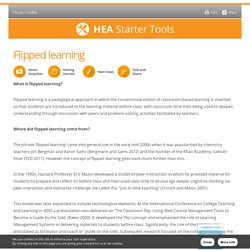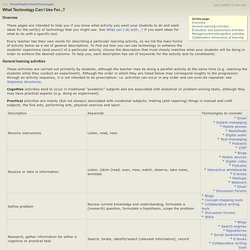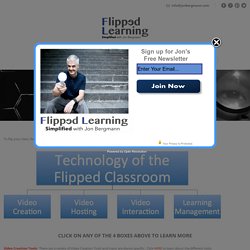

Higher Education Academy. What is flipped learning?

Flipped learning is a pedagogical approach in which the conventional notion of classroom-based learning is inverted, so that students are introduced to the learning material before class, with classroom time then being used to deepen understanding through discussion with peers and problem-solving activities facilitated by teachers. Where did flipped learning come from? The phrase ‘flipped learning’ came into general use in the early mid-2000s when it was popularised by chemistry teachers Jon Bergman and Aaron Sams (Bergmann and Sams 2012) and the founder of the Khan Academy, Salman Khan (TED 2011). However the concept of flipped learning goes back much further than this. In the 1990s, Harvard Professor Eric Mazur developed a model of ‘peer instruction’ in which he provided material for students to prepare and reflect on before class and then used class time to encourage deeper cognitive thinking via peer interaction and instructor challenge.
See: Sector Snapshot. PhoebeMapActivitiesToTechnologies – Phoebe guidance. Overview ¶ These pages are intended to help you if you know what activity you want your students to do and want ideas for the sort(s) of technology that you might use.

See What can I do with...? If you want ideas for what to do with a specific tool. Every teacher has their own words for describing a particular learning activity, so we list the main forms of activity below as a set of general descriptions. To find out how you can use technology to enhance the students’ experience (and yours!) General learning activities ¶ These activities are carried out primarily by students, although the teacher may be doing a parallel activity at the same time (e.g. coaching the students while they conduct an experiment).
Cognitive activities tend to occur in traditional “academic” subjects and are associated with analytical or problem-solving tasks, although they may have practical aspects (e.g. doing an experiment). Top | Contents page Evaluation and assessment activities ¶ The Flipped Class: Myths vs. Reality. Editor's Note: On the heels of our viral posts in over 100 countries about the flipped classroom earlier this year (links below), we asked Jon Bergmann if he could share some of the feedback he was receiving in light of the notable interest about this topic. The timing couldn't have been more perfect since he was about to leave for a conference about you-guessed-it, the flipped class. Here is Part 1 of our three part series The Daily Riff. See Part 2 and 3 links below. - C.J.
Westerberg The Flipped Class: What it is and What it is Not by Jon Bergmann, Jerry Overmyer and Brett Wilie There has been a lot of interest in the flipped classroom. Educational Vodcasting - Flipping the Classroom. Flipped Classroom Explained for Teachers- A Must Watch Video. Flipped Learning Network / Homepage. A Short Overview of 12 Tools for Creating Flipped Classroom Lessons.
One of the most frequent requests that I get is for suggestions on developing flipped classroom lessons.

The first step is to decide if you want to create your own video lessons from scratch or if you want to develop lessons based on videos that others have produced. In this post we'll look at tools for doing both. Developing flipped lessons from scratch with your own videos. The benefit of creating your own videos is that you can tailor them to exactly match your curriculum. The drawback to this is that it requires more time on your part. Tools for creating your own flipped video lessons: The Knowmia Teach iPad app is an excellent app for creating your own whiteboard videos. Educreations is a free iPad app that turns your iPad into a whiteboard. In the free eduClipper iPad app you can create instructional videos on a whiteboard in the Khan Academy style. If you don't have an iPad, PixiClip is a good option for creating simple instructional videos. Tools – Flipped Learning Simplified.
To flip your class, there are certain technology tools teachers need to master.

These fit into the following four categories Video Creation Tools: There are a variety of Video Creation Tools and many are device specific. Click HERE to learn about the different tools. Video Hosting: Once the video is created, the video has to be placed online for students to access. Click HERE to see a variety of options Video Interaction: Software now exists where formative assessments can be built into the flipped videos.
Learning Management: Just hosting the video is often not enough: There exists Learning Management solutions which many teachers find useful to house all of a teachers digital content. Hardware Recomenations: Though you typically simply need some sort of device like a computer or tablet device, there are some other produts that can help enhance the creation of the videos. The Flipped Class: Getting Stakeholders on Board. Flipped Learning Simplified. Youtube. What is Flipped Learning? The Flipped Class: Overcoming Common Hurdles. The Flipped Classroom: Which Tech Tools are Right for You? (YouTube Video) Rethinking Space & Time (Flipped Learning Toolkit #1) The Flipped Class: Formative Assessment.